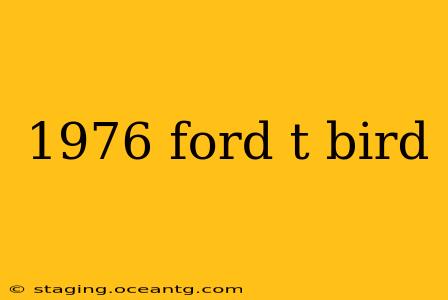The 1976 Ford Thunderbird, a symbol of American automotive design from a bygone era, holds a special place in the hearts of classic car enthusiasts. This article delves into the specifics of this iconic model, exploring its design, performance, and the cultural impact it had—and continues to have. We'll also address some frequently asked questions surrounding this beloved vehicle.
What Made the 1976 Thunderbird Unique?
The 1976 Thunderbird marked a significant shift in design philosophy. After several years of a more sporty, personal luxury car approach, the '76 model embraced a larger, more luxurious persona. This was reflected in its substantial size, showcasing a clear departure from the sleeker lines of previous years. It was a statement of comfort and opulence, representing the burgeoning luxury car market of the mid-1970s. The emphasis was squarely on comfort and spaciousness for both driver and passengers. The longer wheelbase contributed significantly to the increase in interior space.
This generation of Thunderbird also saw a notable change in its styling cues, showcasing a more formal and refined aesthetic. The prominent grille, the broad, squared-off body, and the generous use of chrome all contributed to this distinct personality.
What Engine Did the 1976 Thunderbird Have?
The 1976 Thunderbird offered a range of engine options, reflecting the fuel-conscious atmosphere of the time. The base engine was a 400 cubic inch V8, which provided adequate power for everyday driving. However, buyers could also opt for a larger 460 cubic inch V8, offering increased horsepower and torque for a more spirited driving experience. This larger engine option reflected the continued American preference for powerful vehicles, despite the rising cost of fuel. Both engines were designed with fuel economy in mind compared to their predecessors. This balance between power and efficiency characterized the automotive design choices of the era.
How Much Did a 1976 Thunderbird Cost New?
The price of a new 1976 Thunderbird varied depending on the specific options chosen. However, a base model would have cost somewhere in the range of $5,000-$6,000. This price reflected the increased size, features, and luxury appointments compared to previous models. It’s important to remember that this was during a time of significant inflation, making direct comparisons to modern prices challenging but certainly placing it within a higher price bracket than many other vehicles of its time.
What Were the Common Problems with 1976 Thunderbirds?
Like any vehicle, the 1976 Thunderbird had its share of potential issues. Common problems included electrical gremlins (a common issue for vehicles of this era), issues with the air conditioning system, and potential problems with the braking system. As with any classic car, regular maintenance and diligent care are crucial in mitigating these potential concerns. However, the inherent robustness of the vehicle's mechanical design is a strong point for dedicated enthusiasts.
Is a 1976 Thunderbird a Good Investment?
Whether a 1976 Thunderbird is a good investment depends on several factors, including the car's condition, originality, and the current market demand for classic cars. Well-maintained and original examples can appreciate in value over time, making them attractive options for collectors and enthusiasts. However, the restoration costs can be substantial, so thorough research and realistic expectations are crucial before purchasing one. The investment potential is intertwined with the condition of the vehicle and the dedication of its owner.
Conclusion: The Enduring Legacy of the 1976 Thunderbird
The 1976 Ford Thunderbird stands as a testament to a particular era in automotive history. Its blend of luxury, size, and power cemented its place in the American automotive landscape. While mechanical challenges are possible, the rewarding experience of owning and driving such a vehicle makes it an attractive prospect for those with an appreciation for automotive history and classic design. Thorough research and careful consideration are crucial before making a purchase, but for the right individual, this classic beauty remains an enticing and worthwhile option.
